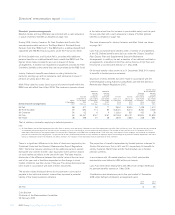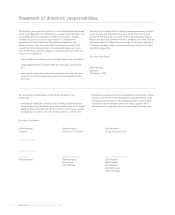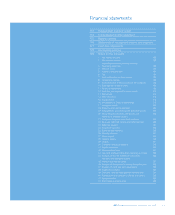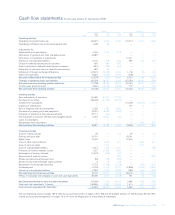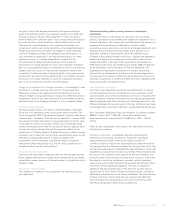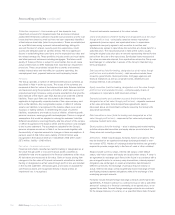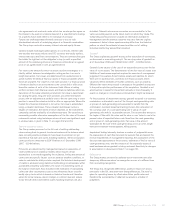RBS 2008 Annual Report Download - page 179
Download and view the complete annual report
Please find page 179 of the 2008 RBS annual report below. You can navigate through the pages in the report by either clicking on the pages listed below, or by using the keyword search tool below to find specific information within the annual report.
Accounting policies
RBS Group Annual Report and Accounts 2008178
1. Presentation of accounts
The accounts are prepared in accordance with International Financial
Reporting Standards issued by the International Accounting Standards
Board (IASB) and interpretations issued by the International Financial
Reporting Interpretations Committee of the IASB (together IFRS) as
adopted by the European Union (EU). The EU has not adopted the
complete text of IAS 39 ‘Financial Instruments: Recognition and
Measurement’; it has relaxed some of the standard’s hedging
requirements. The Group has not taken advantage of this relaxation and
has adopted IAS 39 as issued by the IASB: the Group’s financial
statements are prepared in accordance with IFRS as issued by the
IASB. The date of transition to IFRS for the Group and the company
(The Royal Bank of Scotland Group plc) and the date of their opening
IFRS balance sheets was 1 January 2004.
The Group adopted IFRS 8 ‘Operating Segments’ with effect from 1
January 2008. Early adoption of IFRS 8 has not materially affected
segmental disclosures.
In October 2008, the IASB issued and, the European Union endorsed,
amendments to IAS 39 ‘Financial Instruments: Recognition and
Measurement’ to permit the reclassification of financial assets out of
the held-for-trading (HFT) and available-for-sale (AFS) categories
subject to certain restrictions. Transfers must be made at fair value and
this fair value becomes the instruments’ new cost or amortised cost.
The amendments are effective from 1 July 2008. Reclassifications
made before 1 November 2008 were backdated to 1 July 2008;
subsequent reclassifications were effective from the date the
reclassification was made.
The Group has reclassified certain loans and debt securities out of the
held-for-trading and available-for-sale categories into the loans and
receivables category. It has also reclassified certain debt securities out
of the held-for-trading category into the available-for-sale category. The
balance sheet values of these assets, the effect of the reclassification
on the income statement and the impairment losses relating to these
assets are shown in Note 11 Financial instruments on page 208.
The 2007 comparative amounts have been restated for the netting of
certain derivative asset and derivative liability balances with the London
Clearing House as described in Note 13; the finalisation of the ABN AMRO
acquisition accounting as set out in Note 34; and for the classification of
Banco Real as a discontinued operation as described in Note 20.
The Group is not required to include reconciliations of shareholders’
equity and net income under IFRS and US GAAP in its filings with the
Securities and Exchange Commission in the US.
The company is incorporated in the UK and registered in Scotland.
The accounts are prepared on the historical cost basis except that the
following assets and liabilities are stated at their fair value: derivative
financial instruments, held-for-trading financial assets and financial
liabilities, financial assets and financial liabilities that are designated as
at fair value through profit or loss, available-for-sale financial assets and
investment property. Recognised financial assets and financial liabilities
in fair value hedges are adjusted for changes in fair value in respect of
the risk that is hedged.
The company accounts are presented in accordance with the
Companies Act 1985.
2. Basis of consolidation
The consolidated financial statements incorporate the financial
statements of the company and entities (including certain special
purpose entities) that continue to be controlled by the Group (its
subsidiaries). Control exists where the Group has the power to govern
the financial and operating policies of the entity; generally conferred by
holding a majority of voting rights. On acquisition of a subsidiary, its
identifiable assets, liabilities and contingent liabilities are included in the
consolidated accounts at their fair value. Any excess of the cost (the fair
value of assets given, liabilities incurred or assumed and equity
instruments issued by the Group plus any directly attributable costs) of
an acquisition over the fair value of the net assets acquired is
recognised as goodwill. The interest of minority shareholders is stated
at their share of the fair value of the subsidiary’s net assets.
The results of subsidiaries acquired are included in the consolidated
income statement from the date control passes up until the Group
ceases to control them through a sale or significant change in
circumstances.
All intra-group balances, transactions, income and expenses are
eliminated on consolidation. The consolidated accounts are prepared
using uniform accounting policies.
3. Revenue recognition
Interest income on financial assets that are classified as loans and
receivables, available-for-sale or held-to-maturity and interest expense
on financial liabilities other than those at fair value through profit or loss
are determined using the effective interest method. The effective
interest method is a method of calculating the amortised cost of a
financial asset or financial liability (or group of financial assets or
liabilities) and of allocating the interest income or interest expense over
the expected life of the asset or liability. The effective interest rate is the
rate that exactly discounts estimated future cash flows to the
instrument’s initial carrying amount. Calculation of the effective interest
rate takes into account fees payable or receivable, that are an integral
part of the instrument’s yield, premiums or discounts on acquisition or
issue, early redemption fees and transaction costs. All contractual terms
of a financial instrument are considered when estimating future cash
flows.
Financial assets and financial liabilities held-for-trading or designated as
at fair value through profit or loss are recorded at fair value. Changes in
fair value are recognised in profit or loss together with dividends and
interest receivable and payable.
Commitment and utilisation fees are determined as a percentage of the
outstanding facility. If it is unlikely that a specific lending arrangement
will be entered into, such fees are taken to profit or loss over the life of
the facility otherwise they are deferred and included in the effective
interest rate on the advance.


